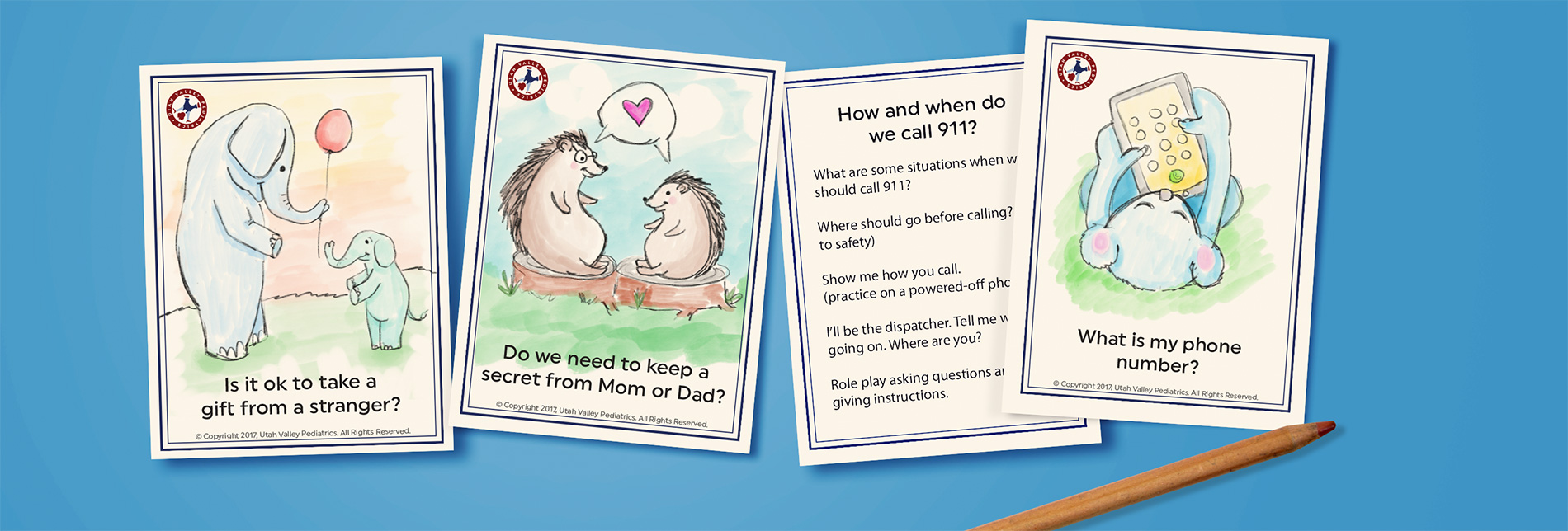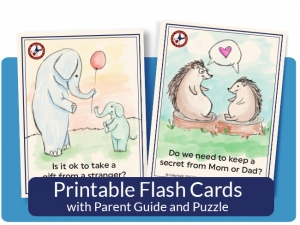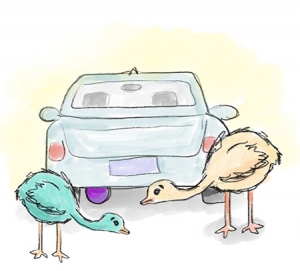
Article at a Glance
The national statistics on preventable childhood injury are staggering. In the mid-2000s, Utah was on par with national averages but, as national preventable-injury rates have declined in recent years, Utah has been moving in the opposite direction.
Parents of preschool-age and kindergarten-age children can and do take many precautions. However, parents simply cannot be at their child’s side at every moment. As such, instilling in children the means to keep themselves safe is a critical responsibility. When you empower your kindergartener with the following information, you can rest easier in the knowledge that your child knows what to do when dangerous situations arise.
 1. Know how to spell your full name, and memorize your parents’ cell phone numbers.
1. Know how to spell your full name, and memorize your parents’ cell phone numbers.In the modern era, we are all accustomed to our contacts lists. Honestly, how many phone numbers have you committed to memory? Even if kindergarteners have cell phones (and some do!) contacts lists will not help them if they are separated from their phones. Kids should know how to correctly spell their full names and addresses, and they should have important phone numbers memorized. When they can give this information to authorities, it makes reconnecting parent and child much easier. Make a game out of teaching your child this critical information, and quiz your preschooler often. Use flashcards or make the Netflix password your cell phone number. Combining a visual and manipulative element is often helpful for memorization. Try writing out your phone number on separate post-it notes and letting your child practice ordering it correctly, or download our printable phone number puzzle.
Non-fatal falls, being struck by an object, and animal bites are some of the most common injuries children less than 5 years old suffer nationwide. Most accidents are preventable. Teach your child to avoid heights, to play safely, and to stay away from strange animals – even a friend’s pet dog.
Unfortunately, not every injury children suffer are accidents. Annually, Utah ranks among the top 10 states in instances of child sexual abuse. A knowledgeable parent is one of a preschooler’s best defenses against sexual abuse. Arm yourself with facts, such as this list of Myths about Child Sexual Abuse from the National Children’s Advocacy Center.
 3. Stay away from swimming pools, lakes, rivers and shorelines unless your parents give you permission to get in the water.
3. Stay away from swimming pools, lakes, rivers and shorelines unless your parents give you permission to get in the water.According to the CDC, the leading cause of death for preschool-age children nationwide is drowning. Ensure that your child knows how to swim, but also be aware of the dangers bodies of water and containers pose. A five-gallon bucket with just a small amount of water poses a deadly drowning risk to toddlers and many drowning accidents occur when children accidentally fall off docks or other waterside structures.
Consider taking a CPR class from an organization such as the Utah chapter of the American Red Cross. The life-saving techniques you will learn could mean all the difference when every second counts.
 4. Buckle your seatbelt every time, and never play around parked cars.
4. Buckle your seatbelt every time, and never play around parked cars.Every parent teaches their child not to play in the road. But did you know most of the vehicle-pedestrian fatalities among Utah children less than 4 years old occur in driveways? Worst of all, the driver is typically a parent. Be sure your child understands the dangers parked cars represent and try to make a habit out of walking around your vehicle before you get in and start the engine.
Another all-too-common cause of injury to young children is vehicular accidents. Use a booster seat until your child is 4 feet 9 inches tall and weighs more than 80 pounds. Be certain anyone who is driving your child does the same.
Teach your child to stay in place if you become separated in public, and to call out your real name (not just “Mom” or “Dad”) so you don’t mistake the calls as coming from another child. Kids should know that, if they are lost and calling for a parent does not work, it is okay to ask for help.
Help them learn to choose people who are likely trustworthy, specifically a mom who has kids with her. A police officer or store clerk is another safe bet, but preschoolers often have trouble distinguishing uniforms from other types of clothing. Among the non-uniformed public, another mother is more likely to remain with your child until the two of you are reunited, as males often fear the stigma of being misconstrued as a predator.
 6. Never accept anything from or go anywhere with anyone without checking with your parents to make sure it is okay.
6. Never accept anything from or go anywhere with anyone without checking with your parents to make sure it is okay.Though child abduction is thankfully a rare occurrence, you should teach your preschooler to avoid accepting things without your permission so that they instinctively avoid approaching strangers.
Most school policies require identification for anyone else to pick up your child, but these policies are imperfectly enforced. It is a better idea to discuss pickup arrangements with your child in advance and to teach your child that you would never send a stranger to pick them up.
In the vast majority of non-acquaintance abduction cases, children are first approached within one quarter mile from home. When kindergartners know that they are not allowed to go anywhere without permission, they are more likely to seek out a parent if approached. While simply wandering off is far more common in children with disabilities, it’s still a common cause of preschoolers getting lost. Your vigilance is your child’s best defense, but teaching a preschooler to remain within a confined area and to always check in is a good, safe practice.
Each of us has a voice inside our head that tells us when things are not right or when something might get us hurt. Teaching kids entering school to trust their intuition will put them on a path to keeping themselves safe. Most parents want their children to be polite, especially to adults. Unfortunately, predators are aware of this fact and will use it to their advantage. Making sure that your preschooler understands the difference between proper and improper requests takes time, patience, and repetition.
In an emergency, the ability to stay calm and get help can save valuable time. Be sure your child knows how to use your cell phone to dial 911 and what constitutes a 911-level emergency. Teach them to effectively communicate the situation to the dispatcher by role-playing.
Landlines give Caller ID information that tells authorities where the call is coming from, but, when a call is made from a cell phone, emergency services receive no such information. Practicing how to recite their address or describe their surrounding can help normalize a traumatic so that communicating effectively becomes second nature.
 10. You can always tell your parents anything. No secrets!
10. You can always tell your parents anything. No secrets!Healthy children fear consequences from their parents for behaving badly. This fear is the result of consistent and patient parenting, but instilling it can have unintended consequences as well. Sometimes, children fear angering or disappointed their parents to such an extent that they can be manipulated. Teach your child that no one has the right to request that they keep a secret from mom and dad. Of course, things like surprise parties and presents are different, but toddlers and preschoolers may have trouble distinguishing between good and bad secrets. As their cognitive abilities develop, kids can learn to keep safe, happy secrets. Even then, teaching them that there is nothing that they cannot tell their parents will help them make sense of these complicated situations.
Of course, no list of this type can ever be complete. As the world is evolving and changing at an ever more rapid pace, new dangers arise for children of all ages. Therefore, keeping up with new child-safety information is one of the more pressing responsibilities of parenting in modern times.
For more safety tips for your preschooler or kindergartner: